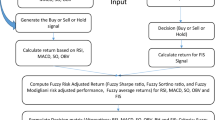Abstract
Financial markets constitute an emerging area for design and application of computational intelligent decision support tools. From numerous research studies, the main conclusions drawn refer to the existence of boundaries on current forecasting capabilities, paired with the need for innovative modeling frameworks structured on benefit/risk principles. As such, the idea to approximate the investors’ reasoning process seems to be a promising direction for decision analysis and forecasting purposes. To underpin such a scheme, Fuzzy Cognitive Maps (FCM) constitute an interesting mathematical/simulation alternative. Thereby, this methodology is exploited to build a stock price forecasting system. In this work, however, proportionate significance sustains the theoretical and practical modifications, in order to enhance the adaptive potential and simulation effectiveness of FCM-based models. Particular emphasis is given on the capability of FCMs to capture non-linear causal propagations and to simulate complex environmental phenomena, like the inertial and multi-stimulus forces exhibited by a plethora of physical and technical systems.
Similar content being viewed by others
References
Koulouriotis D.E., Emiris D.M., Diakoulakis I.E. and Zopounidis C. (2002), “Behavioristic Analysis and Comparative Evaluation of Intelligent Methodologies for Short-term Stock Price Forecasting”,Fuzzy Economic Review Journal, vol. 7(2), 23–57.
Kimoto T., Asakawa K., Yoda M. and Takeoka M. (1990), “Stock Market Prediction System with Modular Neural Networks”,IEEE International Joint Conference on Neural Networks, 1–6.
Refenes N.A., Zapranis A. and Francis G. (1994), “Stock performance modeling using neural networks: A Comparative Study With Regression Models”,Neural Networks, vol. 7, 375–388.
Kim S.H. and Chun S.H. (1998), “Graded Forecasting Using an Array of Bipolar Predictions: Application of Probabilistic Neural Networks to a Stock Market Index”,International Journal of Forecasting, vol. 14, 323–337.
Lam K., Chiu K. and Chan W. (1995), “An embedded fuzzy knowledge base for technical analysis of stocks”,3 rd International Conference on Neural Networks in the Capital Markets, 317–330.
Chou S.T., Yang C., Chen C. and Lai F. (1996), “A Rule-based Neural Stock Trading Decision Support System”,IEEE/IAFE Conference on Computational Intelligence for Financial Engineering, 148–154.
Diakoulakis I.E., Koulouriotis D.E. and Emiris D.M (2002), “A Review of Stock Market Prediction using Computational Methods”, inComputational Methods in Decision-Making, Economics and Finance, Kontoghiorghes E., Rustem B. and Siokos S. (editors), Kluwer Applied Optimization Series, 67–91.
Axelrod R. (1976),Structure of Decision: The Cognitive Maps of Political Elites, Princeton University Press.
Zimmermann H.J. (1996),Fuzzy set theory and its applications, 3rd edition, Kluwer Academic Publishers.
Klir G.J. and Folger T.A. (1988),Fuzzy sets, uncertainty and information, Prentice Hall.
Kosko B. (1986), “Fuzzy Cognitive Maps”,International Journal of Man-Machine Studies, vol. 24, 65–75.
Kosko B. (1992),Neural networks and fuzzy systems: a dynamical systems approach to machine intelligence, Prentice Hall.
Zhang W.R., Chen S.S. and Bezdek J.C. (1989), “Pool2: A Generic System for Cognitive Map Development and Decision analysis”,IEEE Transactions on Systems, Man and Cybernetics, vol. 19, 31–39.
Ndousse T.D. and Okuda T. (1996), “Computational intelligence for distributed fault management in networks using fuzzy cognitive maps”,IEEE International Conference on Communications, vol. 3, 1558–62.
Miao Y. and Liu Z.Q. (2000), “On causal inference in Fuzzy Cognitive Maps”,IEEE Transactions on Fuzzy Systems, vol. 8(1), 107–119.
Kim H.S. and Lee K.C. (1998), “Fuzzy implications of fuzzy cognitive map with emphasis on fuzzy causal relationship and fuzzy partially causal relationship”,Fuzzy Sets and Systems, vol. 97, 303–313.
Tsadiras, A.K. and Margaritis, K.G. (1997), “Cognitive mapping and certainty neuron fuzzy cognitive maps”,Information Sciences, vol. 101, 109–130.
Park, K.S. and Kim, S.H. (1995), “Fuzzy cognitive maps considering time relationships”,International Journal Human-Computer Studies, 157–168.
Hagiwara M. (1992), “Extended fuzzy cognitive maps”,IEEE International Conference on Fuzzy Systems, 795–801.
Koulouriotis D.E., Diakoulakis I.E. and Emiris D.M. (2001), “Anamorphosis of FCMs for Operation in Ambiguous and Multi-Stimulus Real World Environments”,10th IEEE International Conference on Fuzzy Systems, 1156–1159.
Lee K.C. and Kim H.S. (1997), “A Fuzzy Cognitive Map-Based Bi-Directional Inference Mechanism: An Application to Stock Investment Analysis”,International Journal of Intelligent Systems in Accounting, Finance & Management, vol. 6, 41–57.
Koulouriotis D.E., Diakoulakis I.E. and Emiris D.M. (2001), “A Fuzzy Cognitive Map-based Stock Market Model: Synthesis, Analysis and Experimental Results”,10th IEEE International Conference on Fuzzy Systems, 465–468.
Koulouriotis D.E., Diakoulakis I.E. and Emiris D.M. (2001), “Learning Fuzzy Cognitive Maps using Evolution Strategies: a novel schema for modeling and simulating high-level behavior”,IEEE International Congress on Evolutionary Computation, 364–371.
Cassetti M. (1993), “A neural network system for reliable trading signals”,2 nd Annual International Conference on Artificial Intelligence Applications on Wall Street, 52–57.
Zemke S. (1999), “Nonlinear index prediction”,Physica, vol. 269, 177–183.
Chinetti D., Gardin F. and Rossignoli C. (1993), “A neural network model for stock market prediction”,2nd Annual International Conference on Artificial Intelligence Applications on Wall Street, 64–71.
Belcaro P., Canestrelli E. and Corazza M. (1996), “ANN forecasting models: an application to the Italian stock market”,Badania Operacyjne i Decyzje, 30–48.
Author information
Authors and Affiliations
Corresponding author
Rights and permissions
About this article
Cite this article
Koulouriotis, D.E. Investment analysis & decision making in markets using adaptive fuzzy causal relationships. Oper Res Int J 4, 213–233 (2004). https://doi.org/10.1007/BF02943610
Issue Date:
DOI: https://doi.org/10.1007/BF02943610




